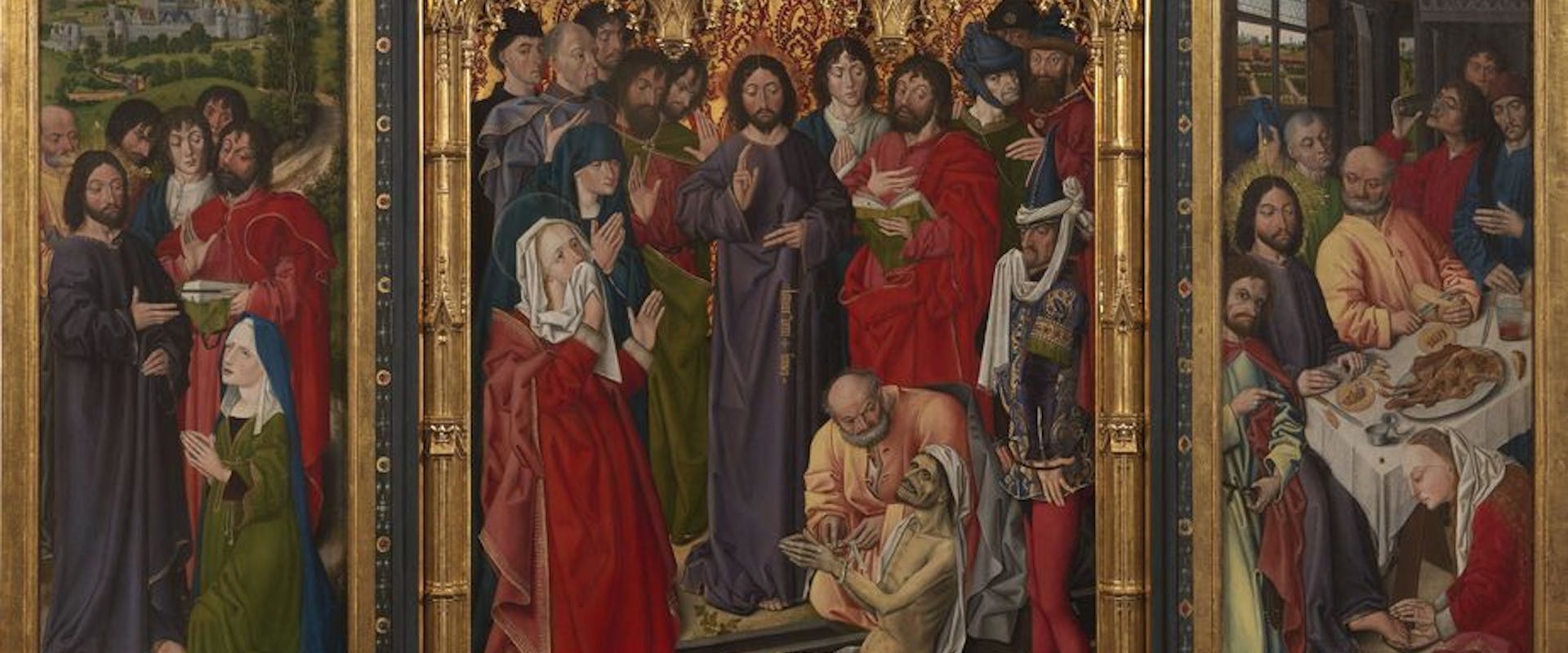The restoration of Nicolas Froment's Triptych despicting the Raising of Lazarus
The painting in question is not only one of the most remarkable works by foreign artists in the Uffizi Gallery’s collection of 15th century paintings, it is also a unique testimonial to the interest that Italian art patrons took in northern European painting in that period.
The triptych illustrates the story of Lazarus and his sisters Martha and Mary. In the left-hand leaf, Martha approaches Jesus to apprise Him of her brother’s death; in the centre, Jesus raises Lazarus from the dead, triggering an emotional response from Marta, Mary and His apostles; and in the right-hand leaf, the story ends with the feast in the house of Simon the Pharisee, where Mary honours the Saviour by anointing His feet. On the back of the panels, the donor, Francesco Coppini, accompanied by another two unidentified figures, is portrayed on the right-hand panel as he prays before the Virgin and Child, depicted on the left-hand panel. An inscription below bears Nicolas Froment’s signature and the date 1461. The painting came to the Gallerie Fiorentine from the Franciscan convent of Bosco ai Frati in the Muggello, in the wake of the dissolution of the religious houses in the Napoleonic era.
It was painted by Nicolas Froment, a painter born in Picardy, of whom only a handful of paintings has survived and who is known chiefly for his work in Provence, from at least 1465, in the service of King René d’Anjou. The triptych, depicting the Raising of Lazarus, Froment’s oldest known work to date, was painted for a prelate from Prato named Francesco Coppini who lived in Flanders, England and France from 1459 to 1462, performing various tasks for Pope Pius II Piccolomini. The realistic portrait on the back of the right-hand panel of the triptych reveals the features of this enterprising, cultured and ambitious prelate.
Born into a humble Prato family in 1402, Francesco embarked on a career in the Church and became a skilled lawyer, whilst also earning recognition for his diplomatic talents. Appointed Bishop of Terni in 1458, he was sent by Pope Pius II to Flanders and to France the following year to collect "Peter’s pence", after which he travelled to England in an effort to broker peace between the Houses of York and Lancaster. Coppini’s support for King Edward IV of the House of York, who was crowned in 1461 after deposing King Henry VI of the House of Lancaster, was disapproved of by the pope who recalled Coppini to Rome and stripped him of his bishopric and his assets in 1463. Coppini donned the Benedictine habit and spent the last few months of his life in the monastery of St. Paul’s Without the Walls, outside Rome, where he died in 1464.
We do not know the triptych’s intended destination (possibly the bishop’s private chapel), but a merchant company is known to have shipped it by sea to Pisa. It is recorded from the 16th century in the convent of San Bonaventura at Bosco ai Frati in the Mugello, which may have received it as a gift from the Medici.
"Coppini’s choice fell on Nicolas Froment, a painter who was still young and whose style was at times both cutting and ironic, all sharp edges – an artist whose patrons were to include the philosopher King René of Anjou when he moved to the south of France shortly afterwards. The choice of Froment reveals Coppini’s ‘strong’, almost rash taste, stirring our imagination into envisaging what the private chapel (which the prelate probably never lived to see completed) would have looked like. The Uffizi’s Sala del Camino, where Froment’s triptych is now on display, can ideally stand in for the intimate and undoubtedly precious space that its patron certainly had in mind". (Eike D. Schmidt, Director of the Gallerie degli Uffizi)
The recently completed restoration has revived the sharp colours of the artist’s palette, vastly improving the observer’s ability to appreciate the picture’s finer details. It has also confirmed that most of the elements making up the triptych, with its features typical of the Flemish tradition, are original. Made entirely of oak, it consists of three panels which were set into their frames, slotted into a groove carved into the thickness of the frame, before being painted. The central panel’s gilded wooden fretwork reminiscent of the arcades in a Gothic cathedral, on the other hand, was applied after the panels were painted. The perimeter of the central panel was altered in the course of an old restoration and neither the hinges connecting the side panels to it nor the leaves’ locking mechanism are original.
Before painting, the panels were prepared with two layers of primer, the first made of calcium carbonate and the second of white lead. A reflectographic inspection, to which the images projected in this room refer, has revealed the existence of a largely freehand preparatory drawing. The paint binder is oil-based and the pigments used include madder and rose madder for the various hues of red, copper resin for the green and indigo in the delicate shading of the niches hosting the Virgin and Child and the donor on the back of the panels.
To mark the completion of the triptych’s restoration and to tie in with its presentation, Daniela Parenti has edited a volume entitled Il restauro del trittico con la Resurrezione di Lazzaro di Nicolas Froment published by Silvana Editoriale.
